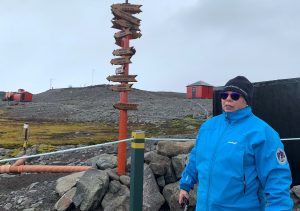
King George Island, Antarctica, Jan 8 (EFE).- How can one go scuba diving in the chilly waters of Antarctica? That was the question posed by the group of 80 female scientific leaders touring the White Continent when they visited Argentina’s Carlini Base, famous for its research projects and for hosting a 2013 concert by the heavy metal rock band Metallica to benefit the planet.
On the sixth day of their Antarctic sojourn, the members of the Homeward Bound expedition, supported by Spain’s Acciona company, visited Argentina’s most important base at the bottom of the world located on King George Island – known as May 25 Island to Argentines – and surrounded by Three Brothers Hill, 210 meters (690 feet) high, and the Fourcade glacier.
The station, commanded by Maj. Mariano Pintos, who welcomed the visitors, includes several orange-colored buildings: the main living quarters, where the base occupants sleep, a restaurant, an aquarium, a treatment plant, a movie theater and, of course, assorted laboratories.
Sharon Robertson, a professor with Australia’s University of Wollongong and a member of Homeward Bound, told the group that in December 2013 the base organized an historic Metallica concert to raise awareness about Antarctica’s importance for the planet.
But, what created excitement among the group was the diving division, one of the few such operations on the continent, which is staffed year-round and has a female military nurse who is an expert in providing medical attention to divers.
“It makes me very proud and happy to be here after so many years of intending to come to Antarctica,” said professional nurse Capt. Sandra Lupiani.
“As a woman, it’s a challenge, an honor above anything, and it’s an adventure,” she added.
First Lt. Ulises Diaz Bozza is in charge of the base’s Diving and Navigation section, an area tasked with taking ocean samples for scientific studies and which has a hyperbaric center with a decompression chamber.
“Dives are made every day, if weather permits, with a maximum duration of an hour, and the depth to which they go is 20 meters (66 feet),” the lieutenant said.
In summer, the divers endure temperatures of between 1-2 C (34-36 F), but in winter it can get down to -12 C (10 F).

Regarding underwater visibility, it’s better in the winter, up to 50 meters. “In summer, due to the sedimentation action of the glacier, visibility drops to 3 meters and there are even places where I can’t even see my wristwatch,” Diaz said.
To be tapped for deployment to Antarctica, the divers, all army troops, must take a one-month frigid water course in southern Argentina, where the temperature is cold. “It’s nothing compared to this, but it allows (them) to start getting acclimatized and to practice using the equipment,” he said.
At the base, everyone is concerned about the nearby Fourcade glacier.
“The glacier’s recession is very noticeable. In January last year, the glacier looked one way and today it’s completely different.
Every day there are iceslides and that’s because of climate change,” said Diaz, bringing tears to the eyes of Costa Rica’s Christiana Figueres, one of the drafters of the Paris Accord who was invited to come on the expedition.
The visit to the base was one of the most enjoyable activities so far for the expedition members because of the personal warmth of the base members and the amount of scientific information they provided in areas such as seismography, climate change and about local mammal and bird species.
The Homeward Bound expedition left the far-southern Argentine port of Ushuaia on Dec. 31 aboard a vessel bearing that city’s name and is scheduled to make a total of about 10 stops on its Antarctic tour, including at the US Palmer Base, Ukraine’s Vernardsky Base and Pleneau Island, next to an iceberg “cemetery.”
